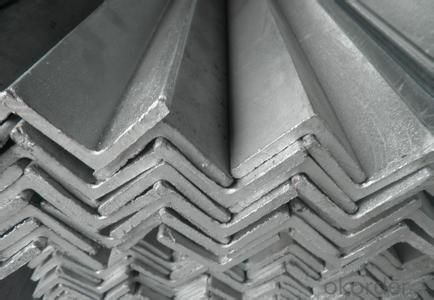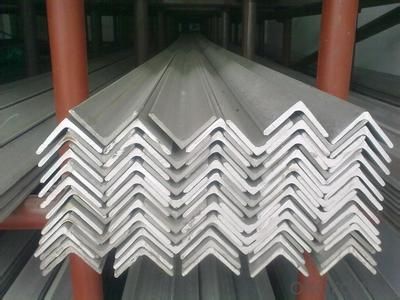Angle Steel ASTM A36 or GB Q235 Q345B or Equivalent for ALL SIZES
- Loading Port:
- China Main Port
- Payment Terms:
- TT or LC
- Min Order Qty:
- -
- Supply Capability:
- -
OKorder Service Pledge
OKorder Financial Service
You Might Also Like
Product Description:
OKorder is offering high quality Hot Rolled Steel I-Beams at great prices with worldwide shipping. Our supplier is a world-class manufacturer of steel, with our products utilized the world over. OKorder annually supplies products to European, North American and Asian markets. We provide quotations within 24 hours of receiving an inquiry and guarantee competitive prices.
Product Applications:
According to the needs of different structures, Angle can compose to different force support component, and also can be the connections between components. It is widely used in various building structures and engineering structures such as roof beams, bridges, transmission towers, hoisting machinery and transport machinery, ships, industrial furnaces, reaction tower, container frame and warehouse etc
Product Advantages:
OKorder's Steel I-Beams are durable, strong, and resist corrosion.
Main Product Features:
· Premium quality
· Prompt delivery & seaworthy packing (30 days after receiving deposit)
· Corrosion resistance
· Can be recycled and reused
· Mill test certification
· Professional Service
· Competitive pricing
Product Specifications:
Manufacture: Hot rolled
Grade: Q195 – 235
Certificates: ISO, SGS, BV, CIQ
Length: 6m – 12m, as per customer request
Packaging: Export packing, nude packing, bundled
Sizes: 25mm-250mm | ||||||||||||
a*t | ||||||||||||
25*2.5-4.0 | 70*6.0-9.0 | 130*9.0-15 | ||||||||||
30*2.5-6.6 | 75*6.0-9.0 | 140*10-14 | ||||||||||
36*3.0-5.0 | 80*5.0-10 | 150*10-20 | ||||||||||
38*2.3-6.0 | 90*7.0-10 | 160*10-16 | ||||||||||
40*3.0-5.0 | 100*6.0-12 | 175*12-15 | ||||||||||
45*4.0-6.0 | 110*8.0-10 | 180*12-18 | ||||||||||
50*4.0-6.0 | 120*6.0-15 | 200*14-25 | ||||||||||
60*4.0-8.0 | 125*8.0-14 | 250*25 | ||||||||||
FAQ:
Q1: How do we guarantee the quality of our products?
A1: We have established an advanced quality management system which conducts strict quality tests at every step, from raw materials to the final product. At the same time, we provide extensive follow-up service assurances as required.
Q2: How soon can we receive the product after purchase?
A2: Within three days of placing an order, we will begin production. The specific shipping date is dependent upon international and government factors, but is typically 7 to 10 workdays.
Q3: What makes stainless steel stainless?
A3: Stainless steel must contain at least 10.5 % chromium. It is this element that reacts with the oxygen in the air to form a complex chrome-oxide surface layer that is invisible but strong enough to prevent further oxygen from "staining" (rusting) the surface. Higher levels of chromium and the addition of other alloying elements such as nickel and molybdenum enhance this surface layer and improve the corrosion resistance of the stainless material.


- Q:How do steel angles contribute to the overall energy efficiency of a building?
- Steel angles contribute to the overall energy efficiency of a building in several ways. Firstly, steel angles are commonly used in the construction of building frames and structures, providing the necessary support and stability. By using steel angles instead of other materials, such as wood or concrete, the building can be constructed with fewer materials and therefore reduce the overall energy consumption during the construction phase. Moreover, steel angles are known for their strength and durability, which allows for longer spans and fewer support columns. This not only maximizes the usable space within the building but also reduces the need for additional heating or cooling systems. By minimizing the number of partitions and obstructions, steel angles enable better airflow and natural lighting, thus reducing the energy required for artificial lighting and ventilation. Additionally, steel angles can be used as a thermal barrier, providing insulation and reducing heat transfer. This helps to maintain a comfortable indoor temperature throughout the year, reducing the reliance on heating and cooling systems and consequently saving energy. Furthermore, steel angles have a high fire resistance, making them a safe choice for building construction. This reduces the need for fireproofing materials and systems, leading to energy savings both during construction and throughout the building's lifespan. Lastly, steel is a highly recyclable material, and steel angles can be recycled at the end of a building's life cycle. By incorporating recycled steel angles into new construction projects, the overall energy consumption and environmental impact can be further reduced. In summary, steel angles contribute to the overall energy efficiency of a building by reducing the amount of materials required during construction, optimizing space utilization, enhancing natural lighting and ventilation, providing thermal insulation, ensuring fire safety, and promoting the use of recyclable materials.
- Q:Are steel angles load-rated?
- Yes, steel angles are load-rated. Steel angles are structural elements that are commonly used in construction and engineering applications. They are designed to withstand various types of loads, including axial loads, bending loads, and shear loads. The load rating of a steel angle refers to its maximum capacity to support a specific amount of load without failure. Load ratings for steel angles are determined through extensive testing and analysis, considering factors such as the material properties, geometry, and design standards. Load ratings are typically provided by manufacturers, and engineers use these ratings to ensure the structural integrity and safety of a project.
- Q:What are the different types of connections used for steel angles in steel frames?
- There are several types of connections used for steel angles in steel frames, including welded connections, bolted connections, and riveted connections. Welded connections involve fusing the angles together using heat, creating a strong and permanent bond. Bolted connections involve using bolts and nuts to secure the angles together, allowing for easy disassembly if necessary. Riveted connections involve using rivets, which are metal pins, to hold the angles together by forming a permanent, tight fit. The choice of connection type depends on the specific requirements of the steel frame and the desired level of strength and durability.
- Q:Decoration materials and what is the difference between the angle steel bracket.
- Angle called angle, the steel strip is perpendicular to each other on both sides into the corner. There are equal angles and unequal angles. The two sides of an equal angle steel are equal in width. The specifications are expressed in millimeters of edge width * edge width * edge thickness. Such as "/ 30 x 30 x 3", that is 30 mm width equal angle, edge thickness of 3 mm. Also available models that model is the number of centimeters wide, such as angle 3#. The model does not mean the size of the different edges and sizes of the same model. Therefore, the width, the edge and the thickness of the angle iron should be filled out in the contract and other documents, so as not to be indicated by the model alone. Standard Specification for hot-rolled equal angle iron is 2#-20#. The angle iron can be made up of different force components according to the different structure, and can also be used as the connecting piece between the components.
- Q:What is the cost of a steel angle?
- The cost of a steel angle can vary depending on various factors such as size, thickness, and market conditions. It is best to check with local suppliers or online retailers to get an accurate and up-to-date price for a specific steel angle.
- Q:Can steel angles be used as supports for mechanical or electrical equipment?
- Yes, steel angles can be used as supports for mechanical or electrical equipment. Steel angles are versatile and strong, making them suitable for a wide range of applications. They can provide stability, rigidity, and support to hold mechanical or electrical equipment in place. The L-shaped design of steel angles allows for easy attachment and installation, making them convenient for various mounting needs. Additionally, steel angles can be easily customized and fabricated to meet specific requirements, ensuring a secure and reliable support system for the equipment.
- Q:Can steel angles be used as bracing elements in a structure?
- Yes, steel angles can be used as bracing elements in a structure. Steel angles are commonly used in construction as they provide excellent strength and stability. When used as bracing elements, steel angles can effectively resist lateral forces and prevent structural deformation or collapse. They are often used to provide additional support and stability to structural members, such as beams or columns, by connecting them together at specific angles. Steel angles can be easily fabricated and installed, making them a versatile and cost-effective choice for bracing elements in various types of structures, including buildings, bridges, and industrial facilities.
- Q:Can steel angles be used for stairs?
- Stairs can indeed utilize steel angles. The construction industry frequently employs steel angles for a multitude of purposes, including the creation of staircases. These angles are frequently employed to provide the necessary structural support for stair treads and risers. By incorporating steel angles, stairs gain durability and stability, rendering them a favored option for both residential and commercial structures. Moreover, steel angles boast adaptability for stair construction as they can be effortlessly tailored and fabricated to meet unique design specifications.
- Q:What are the different surface finishes available for steel angles?
- Some of the different surface finishes available for steel angles include hot-dip galvanized, painted, powder-coated, and untreated/raw.
- Q:What does "angle length" and "limb width" mean?
- The width of a limb refers to the width of the point to the edge of the angle, and the length of the limb corresponds to the length of the edge;Angle called angle, the steel strip is perpendicular to each other on both sides into the corner. There are equal angles and unequal angles. The two sides of an equal angle steel are equal in width. The specifications are expressed in millimeters of edge width * edge width * edge thickness. Such as "/ 30 x 30 x 3", that is 30 mm width equal angle, edge thickness of 3 mm.
1. Manufacturer Overview |
|
|---|---|
| Location | |
| Year Established | |
| Annual Output Value | |
| Main Markets | |
| Company Certifications | |
2. Manufacturer Certificates |
|
|---|---|
| a) Certification Name | |
| Range | |
| Reference | |
| Validity Period | |
3. Manufacturer Capability |
|
|---|---|
| a)Trade Capacity | |
| Nearest Port | |
| Export Percentage | |
| No.of Employees in Trade Department | |
| Language Spoken: | |
| b)Factory Information | |
| Factory Size: | |
| No. of Production Lines | |
| Contract Manufacturing | |
| Product Price Range | |
Send your message to us
Angle Steel ASTM A36 or GB Q235 Q345B or Equivalent for ALL SIZES
- Loading Port:
- China Main Port
- Payment Terms:
- TT or LC
- Min Order Qty:
- -
- Supply Capability:
- -
OKorder Service Pledge
OKorder Financial Service
Similar products
New products
Hot products
Hot Searches
Related keywords



























